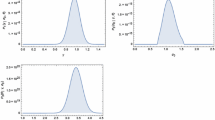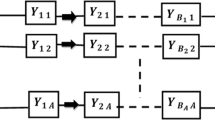Abstract
Under constant-stress accelerated life test, the general progressive type-II censoring sample and the two parameters following the linear Arrhenius model, the point estimation and interval estimation of the two parameters log-normal distribution were discussed. The unknown parameters of the model as well as reliability and hazard rate functions are estimated by using Maximum likelihood (ML) and Bayesian methods. The maximum-likelihood estimates are derived by the Newton–Raphson method and the corresponding asymptotic variance is derived by the Fisher information matrix. Since the Bayesian estimates (BEs) of the unknown parameters cannot be expressed explicitly, the approximate BEs of the unknown parameters. The approximate highest posterior density confidence intervals are calculated. The practicality of the proposed method is illustrated by simulation study and real data application analysis.


Similar content being viewed by others
Data availability
The data used in this study can be obtained from the corresponding author when reasonably requested.
References
Anwar S (2014) Estimation of constant-stress partially accelerated life test plans for Rayleigh distribution using type-II censoring. Int J Eng Sci Res Technol 3(9):327–332
Balakrishnan N, Aggarwala R (2000) Progressively censoring: theory. In: Methods and applications. Birkhäuser, Boston
Boyko KC, Gerlach DL (1989) Time dependent dielectric breakdown of 210A oxides. In: 27th International reliability physics symposium, pp 1–8
Chen M, Shao Q (1999) Monte Carlo estimation of Bayesian credible and HPD intervals. J Comput Graph Stat 8(1):69–92
Gilks WR, Wild P (1992) Adaptive rejection sampling for Gibbs sampling. Appl Stat 41(2):337–348
Hiergeist P, Spizer A, Rohl S (1989) Lifetime of oxide and oxide-nitro-oxide dielectrics within trench capacitors for DRAMs. IEEE Trans Electron Devices 36(5):913–919
Ismail AA (2015) Bayesian estimation under constant-stress Partially accelerated life test for Pareto distribution with type-I censoring. Strength Mater 47(4):633–641
Kimber AC (1990) Exploratory data analysis for possibly censored data from skewed distribution. J R Stat Soc Appl Stat 39(1):21–30
Lawless JF (2003) Statistical models and methods for lifetime data. Wiley, Hoboken
Lv SS, Niu Z, Qu L, He S (2015) Reliability modeling of accelerated life tests with both random effects and nonconstant shape parameters. Qual Eng 27(3):329–340
Mahmoud MAW, El-Sagheer RM, Nagaty H (2017) Inference for constant-stress partially accelerated life test model with progressive type-II censoring scheme. J Stat Appl Probab 6(2):373–383
Meeter CA, Meeker WQ (1994) Optimum accelerated life test with a nonconstant scale parameter. Technometrics 36:71–83
Nelson W (1984) Fitting of fatigue curves with constant standard deviation to data with runouts. J Test Eval 12(2):69–77
Seo JH, Jung M, Kim CM (2009) Design of accelerated life test sampling plans with a nonconstant shape parameters. Eur J Oper Res 197(2):659–666
Shi YM, Jin L, Wei C, Yue H (2013) Constant-stress accelerated life test with competing risks under progressive type-II hybrid censoring. J Adv Mater Res 712–715(2):2080–2083
Wang L (2018) Estimation of exponential population with nonconstant parameters under constant-stress model. J Comput Appl Math 342:478–494
Wang L (2018) Estimation of constant-stress accelerated life test for Weibull distribution with nonconstant shape parameter. J Comput Appl Math 343:539–555
Xu A, Fu J, Tang Y, Guan Q (2016) Bayesian analysis of constant-stress accelerated life test for the Weibull distribution using noninformative priors. Appl Math Model 12(2):119–126
Yan Z, Zhu T, Peng X, Li X (2017) Reliability analysis for multi-level stress testing with Weibull regression model under the general progressively type-II censored data. J Comput Appl Math 330:28–40
Zheng G, Shi Y (2013) Statistical analysis in constant-stress accelerated life tests for generalized exponential distribution based on adaptive type-II progressive hybrid censored data. Chin J Appl Probab Stat 29(4):363–380
Acknowledgements
The authors would like to thank the editors and reviewers for their constructive suggestions to improve the paper.
Funding
This research is supported by National Natural Science Foundation of China (No. 11861049) and Natural Science Foundation of Inner Mongolia (No. 2020LH01002).
Author information
Authors and Affiliations
Corresponding author
Ethics declarations
Conflict of interest
The authors declare that they have no competing interests.
Additional information
Publisher's Note
Springer Nature remains neutral with regard to jurisdictional claims in published maps and institutional affiliations.
Appendix A
Appendix A
Let \(\xi _i(\mu )=\frac{\ln x_{i:r_{i}+1}-\mu \theta _{1}^{\phi _{i}}}{\sigma {\theta _{2}}^{\phi _{i}}},\) \(\xi _{i:j}(\mu )=\frac{\ln x_{i:j}-\mu \theta _{1}^{\phi _{i}}}{\sigma {\theta _{2}}^{\phi _{i}}}, i=1,\ldots ,k,~j=r_{i}+1,\ldots ,m_i,\) we have that
First, in Eq. (31), \(\frac{\mathrm{d}^2log\pi (\mu )}{\mathrm{d}\mu ^2}\le 0\) because \(\pi (\mu )\) is log-concave. Next, we demonstrate that \(\frac{\partial \Big (\frac{\varphi [\xi _i(\mu )]\cdot \xi _i'(\mu )}{\Phi [\xi _i(\mu )]}\Big )}{\partial \mu }\le 0\) and \(\frac{\partial \Big (\frac{\varphi [\xi _{i:j}(\mu )]\cdot \xi _{i:j}'(\mu )}{1-\Phi [\xi _{i:j}(\mu )]}\Big )}{\partial \mu } \ge 0.\)
Without loss of generality, let \(A(\mu )=\frac{\ln x-\mu \theta _{1}^{\phi }}{\sigma {\theta _{2}}^{\phi }}\), we have that
And
where \(g_1(\mu )=A(\mu )\cdot \Phi [A(\mu )]+\varphi [A(\mu )]\). Then
Namely, \(g_1(\mu )\) is decreasing about \(\mu\). Apparently,
By simply taking the limit, we can get
Therefore, \(g_1(\mu )\ge 0\). Thus, \(\frac{\partial \Big (\frac{\varphi [A(\mu )]\cdot A'(\mu )}{\Phi [A(\mu )]}\Big )}{\partial \mu }\le 0\).
where \(g_2(\mu )=A(\mu )\cdot \{1-\Phi [A(\mu )]\}-\varphi [A(\mu )]\), then
Therefore, \(g_2(\mu )\) is decreasing about \(\mu\). Apparently, we have
It indicates that
Further, we have
Let’s do the simple limit again,
We obtain that \(g_2(\mu )\le 0\), further \(\frac{\partial \Big (\frac{\varphi [A(\mu )]\cdot A'(\mu )}{1-\Phi [A(\mu )]}\Big )}{\partial \mu }\ge 0\). Hence, \(\frac{\partial ^2\log \pi (\mu |\sigma ,\theta _{1},\theta _{2},{\varvec{x}})}{\partial \mu ^2}\le 0\), namely, \(\pi (\mu |\sigma ,\theta _{1},\theta _{2},{\varvec{x}})\) is log-concave.
Rights and permissions
About this article
Cite this article
Cui, W., Yan, Zz., Peng, Xy. et al. Reliability analysis of log-normal distribution with nonconstant parameters under constant-stress model. Int J Syst Assur Eng Manag 13, 818–831 (2022). https://doi.org/10.1007/s13198-021-01343-0
Received:
Revised:
Accepted:
Published:
Issue Date:
DOI: https://doi.org/10.1007/s13198-021-01343-0




